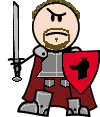Mike_G's already covered the majority of this topic, but I do want to throw something else out there.
Having studied MS I.33 (sword & buckler) at some length, I can say that the system explicitly discourages attacks to the leg. Why? Normally the idea when fighting with a sword and shield is to strike low and cover your head with your shield from your opponent's counterstroke. In I.33, the buckler and sword are generally moved as one unit, simultaneously blocking an opponent's strike and striking in the opposite line with the wrists almost "cuffed" together. In essence, you're using a single weapon that both defends and attacks. That's the trick - with a SINGLE weapon, you do not generally attack to the legs.
You ascertain, correctly, that to strike to the legs from a reasonable distance (that is, not so close that neither of you has to step to strike the other) you are forced to extend forward slightly and expose your head to a counterstrike. You also realize that the best defense against a leg attack is to step back with the leading leg and to bring your weapon around at the exposed head of the enemy. When using a single weapon, if you attack the enemy's leg, he will simply step back with the lead leg and kill you, because you've no way to defend the counterattack.
It is only when paired with a secondary weapon (read: shield) that allows you to defend the head does a strike to the leg become feasible and survivable. It's what allows you to follow Mike_G's information about feinting in the first place. That's what makes fighting with a shield so different that fighting with a single weapon. Fighting with shields is actually VERY mobile and fast, not because two guys are humping each other while they try to "wrap" blows around each other, but because each is striking at either the head or exposed leg, which must be defended and maneuvered to avoid a fight-ending stroke. Fights between individual shield fighters tend to drift in a circle around the shield side of whomever doesn't have the initiative - this mobility is anathema to the stereotypical 5-foot 10, 300lb SCAdian.
View Single Post
-
2008-05-16, 08:29 PM (ISO 8601)Ogre in the Playground


- Join Date
- Jan 2007
- Location
- Covington, KY
- Gender

 Re: Got a Real-World Weapon or Armor Question? Mk. IV
"I'd complain about killing catgirls, but they're dead already. You killed them with your 685 quadrillion damage." - Mikeejimbo, in reference to this
Re: Got a Real-World Weapon or Armor Question? Mk. IV
"I'd complain about killing catgirls, but they're dead already. You killed them with your 685 quadrillion damage." - Mikeejimbo, in reference to this Originally Posted by Dervag
Originally Posted by Dervag


